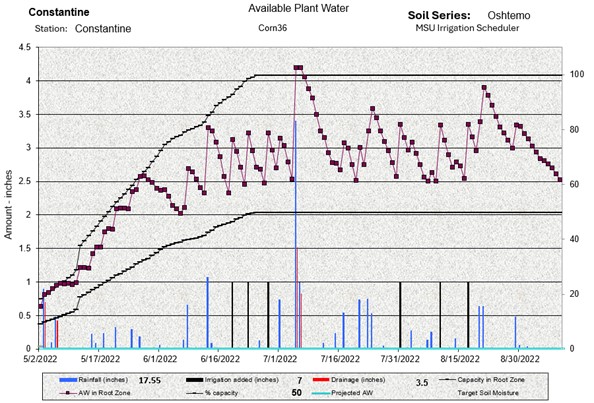Water use reporting: Making it easy to record with irrigation scheduling tools
As the April 1 deadline for past year water use reporting for irrigation and other large water uses came and went, many producers are reminded of the value of keeping good records within their water management.
April 1 is the yearly deadline for water use reporting for the previous year’s irrigation and other large water uses. Many producers are reminded of the value of keeping good records and within their water management during this reporting. Several good, solid irrigation scheduling programs are available for free through Michigan State University Extension, Purdue Extension and other sources. Each of these scheduling programs have the capacity to maintain the records to make it easy for producers to find their monthly large volume or significant water use to complete either the Indiana or Michigan water use report.
If you have the capacity to pump more than 70 gallons per minute from one or more surface or ground water sources used in your operation in Michigan or Indiana, you fall under the registration and reporting requirements.
If you missed the water use reporting deadline, the state staff responsible for water use reports in both states are very willing to help you catch up on your reporting responsibilities. Contact Abby Eaton at the Michigan Department of Agriculture and Rural Development at 517-284-5612 or EatonA@Michigan.gov or Allison Mann at the Indiana Department of Natural Resources Water Division at 317-224-1101 or almann@dnr.in.gov for assistance.
Registration and reporting are a requirement of both Michigan and Indiana irrigators and other large volume water users to meet the requirement of the Great Lakes Compact that both states participate in. An estimate of the past year’s water use on a monthly basis is required within the reporting documents. The reporting takes place over the winter and is an easy task if an irrigator has good irrigation records from the past season.
Irrigation scheduling or the components of irrigation scheduling are part of the water use conservation report done on an annual basis in Michigan. In Indiana, when you first sign up for registration you will also report your water use. The 2018 United States Department of Agriculture Farm and Ranch Irrigation and Water Management Survey both indicate that Indiana and Michigan producers are not commonly using solid scientific-based scheduling systems for water application decisions. This does not mean they over water. In many cases, a scientifically based irrigation scheduling program would call for additional water to meet plant removal.
Michigan State University (MSU) Extension and Purdue Extension offer no-cost irrigation scheduling tools that can be used on most of the commonly irrigated crops in Michigan and Indiana. A few of the tools have year-end reports that total the inches applied to the crop by the month. All tools provide a calendar record of producer irrigation application for both reporting and recordkeeping. A description of a few of the available irrigation scheduling tools follows. More details can be found in the Irrigation Fact Sheet #3 Irrigation Scheduling Tools.
The MSU Soil Water Balance Sheet is a paper version of a checkbook scheduler. Producers can use potential reference evapotranspiration (PETr) data from their own ET gauge station or PETr data form the Purdue Agricultural Center weather station’s PET monitoring tool. Michigan producers can use the MSU Enviroweather data from the irrigation page from their local Enviroweather station. The Soil Water Balance Sheet helps producers convert the PETr into an estimate crop water use for either corn or soybeans in their field.
The MSU Irrigation Scheduler - Excel Version allows greater flexibility and adaptability to irrigators who are comfortable using Excel. This method will provide results for all of Michigan and the upper tier counties in Indiana. Potential reference crop ET can be taken from each of the Enviroweather stations, where the program will use crop-specific coefficients to adjust for your crop stage of growth.
The Purdue Irrigation Scheduler is a simple, computerized irrigation scheduling checkbook model from Purdue University. This method can be used throughout Michigan and Indiana. Crop-specific ET values are estimated using the daily high and low temperatures and rainfall provided by the producer or weather data and can be imported from the internet.
Irrigation Scheduler App - IrrigMSU is a mobile irrigation scheduling app designed as a refined and user-friendly adaptation of the MSU Scheduler - Excel Version. It provides soil water information and recommended irrigation amounts to help meet crop water requirements. A Beta version of the IrrigMSU app is available for both Android and Apple devices.

The primary purpose of irrigation scheduling is to help producers in deciding when and how much water to apply. Effective programs also simplify the process of recording the total amount of water applied each month for water use reporting. The MSU Scheduler graph in Figure 1 displays both rainfall (in blue bars) and irrigation (in black bars) by date and volume, making it easy to monitor and manage water usage.



 Print
Print Email
Email